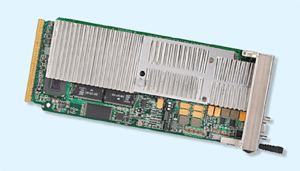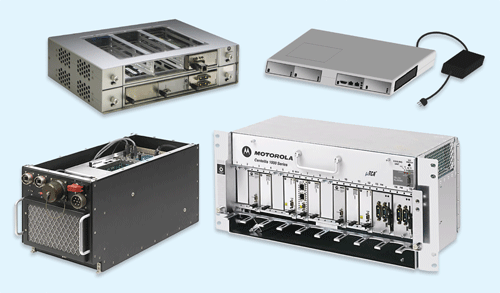MicroTCA’s one to twelve postcard-sized AMC modules and high-speed backplane can use a wide variety of packaging
BY NIGEL FORRESTER
Motorola, Embedded Communications Computing
Tempe, AZ
www.motorola.com/computing
Since being ratified as a standard in mid 2006, MicroTCA has been thought of primarily for a range of telecom applications. This is not surprising since the basic building block was conceived as a hot-swappable mezzanine to add functionality in AdvancedTCA systems that are widely used by many large telco organizations. MicroTCA, however, is suitable for many other applications.
MicroTCA overview
MicroTCA systems are constructed by plugging one to twelve postcard-sized AdvancedMC (AMC) modules into a backplane that has appropriate power, cooling and mechanical resources. Both the AdvancedMC and MicroTCA specifications are defined and controlled by the PICMG organization, www.picmg.org, which has a wide membership of suppliers, end-users, and other interested parties. MicroTCA has a wider variety of AdvancedMC modules on the market that offer more than general purpose x86 processing capability, compared to various other open standards designed for industrial use.

One to twelve postcard-sized AdvancedMC modules fit into a MicroTCA backplane.
Each MicroTCA system is controlled by a special module called a MicroTCA Carrier Hub (MCH), which provides a standard IPMI-based management subsystem to handle the power, cooling, and hot swap of modules. The MCH also provides the switching capability within the system to connect AMC modules that are specified to support Gigabit Ethernet, PCI Express, and serial RapidIO connections.
In practice, MicroTCA systems typically enable simple combinations such as Gigabit Ethernet and SATA for control and a storage interface or PCI Express for local I/O and graphics, but it is possible to implement more complex systems. The backplane consists of up to 21 high-speed serial pipes, which enables MicroTCA systems to scale to suit different applications that need between 100 Mbits/s and 40 Gbits/s of bandwidth.
Theoretically, there are six physical AMC formats, ranging from compact, mid-size, full-size to double width full-size. In reality, there is a convergence towards a few sizes.
A differentiator of MicroTCA is that it is designed to support a wide variety of packaging as required by a specific application. Currently, there are numerous off-the-shelf solutions, ranging from 19-in. shelves for large systems to so-called “pizza box” enclosures for smaller systems.
There is a significant interest in creating packaging specifically for application usage. In fact, many vendors such as Hybricon (Ayer, MA; www.hybricon.com) have shown various ruggedized and conduction cooled boxes that use MicroTCA for military and avionic systems.
Applications
A number of open standards have already been used to address the industrial market, including VMEbus and 3U CompactPCI. Like AMCs and MicroTCA, these formats offer a variety of off-the-shelf boards or modules, such as complex DSP and FPGA designs.
Some off-the-shelf packaging solutions are available and life cycles are usually extended. MicroTCA is a strong candidate to compete in the industrial space because of the ever-expanding choice of AMC modules. Because MicroTCA systems are quite small and easy to package, and because they have evolved around an Ethernet switched architecture, the MicroTCA standard is very appropriate for distributed applications that require data exchange, such as in handheld, semi-portable/benchtop, and fixed installations.
Handheld instruments
Handheld instruments are small, light, and battery operated. Designers normally use an enclosure that follows a corporate branding strategy, which dictates space constraints.
They often have very specific I/O and display requirements that lead them to a custom baseboard design, and then they rely on the open market to supply a plug-on processing module for instrument control or data acquisition. These handheld instruments have traditionally been used in a standalone mode, but regulatory requirements, corporate networking strategies, and demands for easier-to-use instruments are now driving the provision of wireless connectivity.
In the last few years, especially with increasing demand for good-quality graphical-based displays, the trend has been to use controllers based on the Intel x86 architecture because they are easy to program and relatively inexpensive. The many formats of this type of ready-made computer module include Computer On Module (COM), COM Express, ETX, MicroETX, and the PC/104 derivatives.
They all essentially offer a plug-in miniature PC with different bus interfaces back to a baseboard and a selection of I/O such as USB, RS-232, and audio. AdvancedMC modules based on Intel processors are available and can act as a plug-in PC in the same way, although the instrument would be AMC compliant rather than MicroTCA based.
Semi-portable/benchtop equipment
Benchtop and semi-portable equipment is usually ac powered and must be able to sustain a reasonable level of abuse. They benefit from a modular construction where features and options can easily be added to suit user requirements.
For example, test equipment applications can require market or country specific modules or multiple instantiations of the same module to complete parallel testing on a production line. Transportable test instruments may use a general purpose processor for instrument control and display as well as other commercially available modules such as specific I/O for connection to the devices on test and DSP and FPGA modules for calculating test results.
Fixed installations
Fixed industrial applications can range from simple kiosk-style terminals for parking meters to highly complex semiconductor process equipment in a controlled environment to railway signaling equipment in a harsh environment. These examples show how difficult it can be to generalize about the type of equipment that might be used, but there are some useful indicators, such as the need to use alternative type of control processors.
Sometimes the difficulty is driven by a large legacy code base that was written for architectures such as PowerPC, or perhaps the need to use a specific embedded operating system and for security or real time requirements. For safety and economic reasons, the equipment used in fixed installations needs to support long life-cycles and be extremely reliable.
Comparing available choices
It’s easy to see that there is a class of industrial applications that just need add-on PC functionality, with the ideal solution being a form of Computer On Module. The latest COM modules offer good performance and interface to a baseboard at high speed using PCI-Express. A selection of these modules exist based on PCI and even legacy ISA bus interconnects for lower-speed applications, and there is a wide variety of physical form factors to meet many packaging requirements.
Technically, the requirements that should influence designers of industrial equipment to consider MicroTCA include:
The ability to use multiple processing modules connected in a distributed fashion over an Ethernet backplane.The availability of a high-speed serial switched backplane capable of supporting bandwidth up to 40 Gbits/s.The availability of diverse processors, including many-core packet processors, DSP, FPGA, and PowerPC, as well as the latest low-power x86 architecture devices for control processing, on AdvancedMC modules.A wide array of off-the-shelf I/O modules allowing instant development with potential reuse for deployment as well as off-the-shelf development systems.Significant forecasted cost reductions driven by large-volume AdvancedMC usage across other market segments.Hot-swappable modules, which offer quick maintenance advantages to some applications. Some applications will need to prevent the user from removing modules, which can be achieved with system level packaging.The availability off-the-shelf packaging solutions, particularly for ruggedized markets.

MicroTCA systems can use a wide variety of packaging.
The industrial evolution
MicroTCA has the potential to break new ground in terms of price/performance in embedded computing. It has benefited from the work done on AdvancedTCA, inheriting many features that are not available in other embedded architectures, include a compact modular and scalable construction, power dissipation capability, high-speed serial links, service-friendliness, system management, and ruggedness.
MicroTCA also offers tremendous flexibility in packaging options and industrial-grade payload modules, in addition to long-lifecycle management. MicroTCA has the potential to be used as a stable platform for industrial applications for at least 10 years. This investment protection is a key argument for many companies in choosing MicroTCA. ■
can use a wide variety of packaging.
For more on MicroTCA based products, visit http://electronicproducts-com-develop.go-vip.net/boards.asp.
Advertisement
Learn more about Motorola Computer Group





